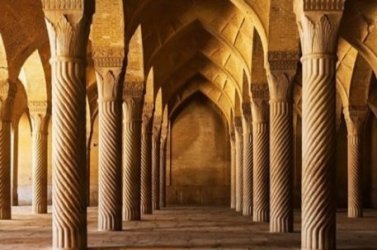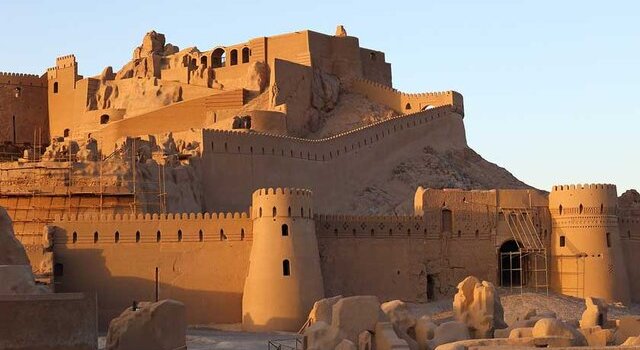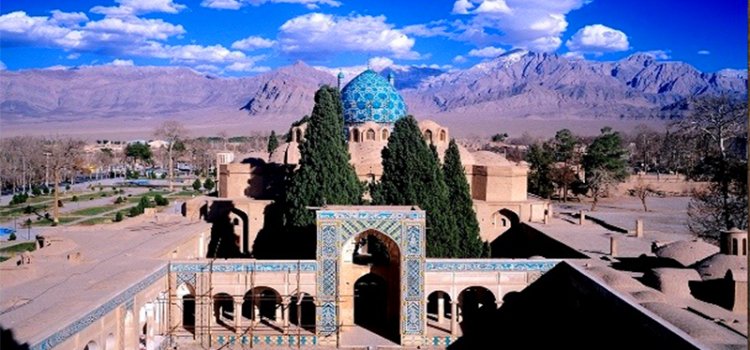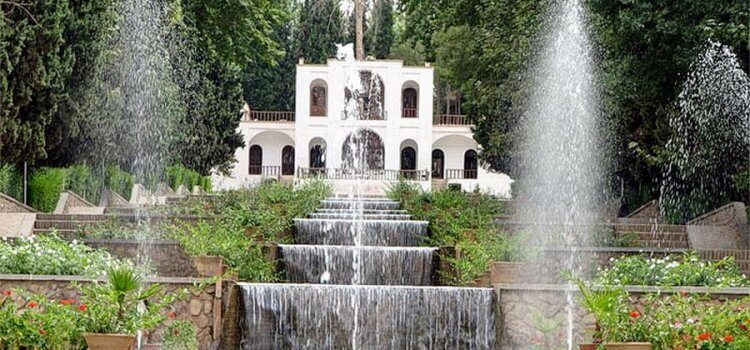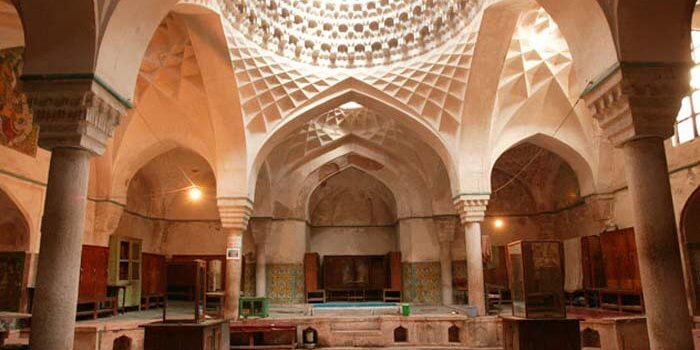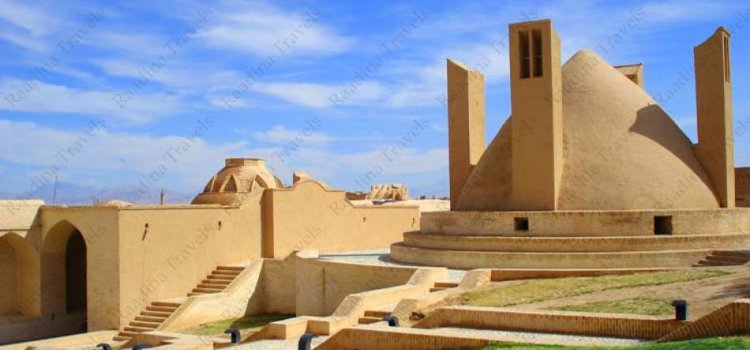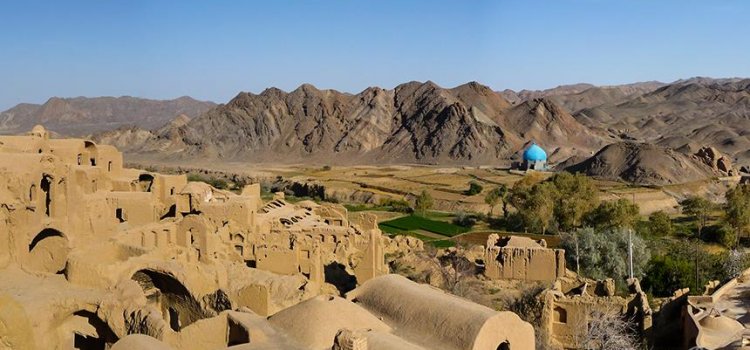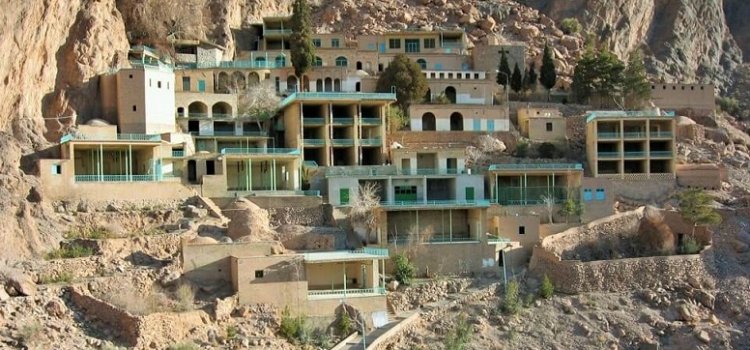Vakil Mosque
Vakil Mosque
Another amazing attraction in Vakil Complex and Shiraz is Vakil Mosque. The harmonious architecture of the mosque and the sense of spirituality it implies are the two basic characteristics which turn this religious site into a cultural and touristic sight.
As part of Karim Khan’s plan to create a new center of town, Vakil mosque was built in the year 1773. The entrance of the mosque, reconstructed during the Qajar period (19th century), is adorned with tiled stalactites, calligraphy, stone friezes and beautiful tile-work which bear mostly pink floral patterns.
As you pass the wooden entrance gate, you will enter a vestibule which takes you to the courtyard of the mosque through a corridor with a 90-degree rotation in relation to the axis of the portal. This cozy rectangular courtyard includes a large rectangular pond in the center, providing the necessary water for the people who come to pray in the mosque. The Eastern and Western sides are covered with two corridors, decorated with arcades.
On the southern and northern sides of the mosque, there are two porches. The northern porch, also called the Pearl Arch, is flanked by two minarets and includes a high vault, decorated with colorful tiling and a beautiful inscription in tholth script representing some versus of the Holy Quran.
The southern porch of the Vakil Mosque leads to the main prayer hall of the mosque which is also the high-light of the mosque. The southern prayer hall of Vakil Mosque is decorated with 48 spiral pillars, in form of tree of life. This special atmosphere creates a spiritual environment where visitors can detach themselves from the ordeals of everyday life and immerse themselves in a universe beyond our material world. As a tip, we should say that you can also take very unique photos for your social media in this prayer hall and among its columns which create unique perspectives.
Another highlight of this prayer hall is its artistically designed mihrab or altar. The plinth on the left-side of the altar is carved out of a single block of a marble. Also, be sure not to ignore the tall, marvelous pulpit of the mosque, built out of green marble.
Bam
Bam
The city of Bam is located 190 km east of Kerman province. It claims the largest mud-brick citadel in the world that is registered as a UNESCO world heritage site. It was located along the trade route from the Iranian central plateau to the Indian subcontinent and was an important military and trade center. The city’s main attraction is the Bam Citadel or Arge-e-Bam which dates back to the Achaemenid era. It was made of 3 concentric ramparts which the central one, dedicated to the governer, was higher. The second part was the military section and the third was residential.
Unfortunately, it was destroyed in a devastating earthquake in 2003 with about 45,000 death toll which was more than the half of population of the city. Some districts were reconstructed and nowadays people can visit them.
Shah Nematolah Vali
Shah Nematolah Vali
The tomb of Shah-Nematolah-Vali, 14th-century Sufi master and poet, head of the Shah-Nematolahi lineage, buried in Mahan, is a perfect example of Sufi mausoleums revered by the local population.
The main courtyard suggests 19th-century Qajar architecture. The plants and the flowers are in coherence with the architecture to evoke the spirituality of the place.
The tomb rests under the dome, the interior part of which retains its decor from the Safavid period (17th century).
A small cell in the corner of the main building is called Chele-Khane and was used during the spiritual seclusion of the Sufis. A courtyard located at the back also presents the beautiful architecture, seeming to welcome the pilgrims coming from far away.
Sufism is the esoteric and mystical view of Islam. The conquest of the Mongols in the 13th century favored the expansion of this religious movement that remained isolated from political life. This movement is currently socially marginal in Iran.
Their virtues as poets, their rhetoric, and even sometimes the superhuman qualities attributed to them make them the object of veneration and sympathy on the part of their supporters.
Shazdeh Garden
Shazdeh Garden
Shazdeh (prince) garden is located on the ring road of Mahan, 35 km southeast of Kerman. It was built during the Qajar period, in 1870. It is one of the nine Persian gardens registered as world heritage by UNESCO.
The garden is located at the foothills of the mountains and enjoys a constant stream of water. The pavilion at the high end of the garden is its architectural heart. The water descends on a natural slope in the eight basins arranged in a staircase structure
In addition to the animation of the water jets, the stream irrigates the trees and flowers to make the garden appear like a hanging garden.
At the entrance, a pretty building delimits the palatial enclosure of the garden of arid nature that surrounds it.
GanjaliKhan Bath
GanjalKhan Bath
in Kerman is part of the Ganjali Khan complex which was built in the 17th century, during the Safavid era, and transformed into an anthropological museum since 1971.
GanjalKhan Bath
in Kerman is part of the Ganjali Khan complex which was built in the 17th century, during the Safavid era, and transformed into an anthropological museum since 1971.
The paintings, the tiling, the stucco work, the arches, and the calligraphy are among the beautiful ornamentations that complete the exceptional architecture of this Hammam.
From the bazaar, a curved corridor gives access to the Bineh (a space that is normally characterized as a semi-hot, semi-humid area) and to avoid a direct view of the interior and to keep a constant temperature.
There is a difference in height around the Bineh so that you can take off your shoes and get ready before heading to the hot section.
The Bineh offered separate spaces according to the profession of the people, traders, employees, and religion. Everyone had their part.
An intermediate passage between the Bineh and Garmkhaneh (a place washing process takes place and is normally characterized as a hot, humid area) is called Miandar.
In the Garmkhaneh, there are wax mannequins showing washing and rinsing.
The place reserved for the governor had a sort of sundial.
The penetration of light through the onyx indicates sunrise (some people entered the public hammam early in the morning to bathe, an ablution ritual that was done before morning prayer).
A model shows the practice of phlebotomy that was done in the past in Hammams. The removal of decayed teeth was going there as well.
In another place, there are cabins for waxing with the famous depilatory powder called Vajebi.
The staging of a massage is a dream … A well-being that we did not deprive ourselves of.
Shahcheragh Shrine in Shiraz
Shahcheragh Holy Shrine is the third biggest pilgrimage site in Iran after the Holy Shrine of Imam Reza (the 8th Shiite Imam) and Fatimah Masumeh in Qom.
Shahcheragh Shrine in Shiraz
Known as the city of wine and poetry, Shiraz is an ideal city for tourists visiting Iran. It is home to palaces of ancient rulers of Iran such as Pasargadae and Persepolis, magnificent gardens, beautiful orange groves, splendid monuments like Nasir al-Mulk Mosque, tombs of unrivaled Iranian poets, for example Sa’di and Hafez, and also a group of war-blooded people whose hospitality is known around the world.
However, apart from all the beauties mentioned above, Shiraz also houses one of the most sacred shrines in Iran, Shahcheragh Holy Shrine. Actually, it is the third biggest pilgrimage site in Iran after the Holy Shrine of Imam Reza (the 8th Shiite Imam) and Fatimah Masumeh in Qom.
Housing the bodies of Imam Reza’s two brothers, Ahmad and Mohammad, the first monument in this site was built over the grave of Ahmad in the 13th century. Apart from its religious significance, the holy Shrine of Shahcheragh is an architectural gem and that is why it is visited by thousands of travelers and tourists each year. The mirror-work decorations in this shrine will leave you amazed for a long long time.
So, if you are in Iran and visiting Shiraz, make sure to pay homage to these two brothers and also enjoy the unique work of Iranian artists that you will see in no other sight in this country.
What does “Shahcheragh” mean?
Well, the first interesting thing to know concerns the name of this shrine, Shahcheragh. Literally, Shahcheragh means “the King of the Light.” But why the king of the light?
Years ago, in a dark night, one of the most significant clerics of Shiraz, Ayatullah Dastghaib, noticed a strange light in the graveyard which located in this neighborhood. As this event occurred for several times, the Ayotullah decided to investigate the source of the light. After some attempts, he finally discovered that the light emanated from a grave within the graveyard. So, the grave emitting that peculiar light was excavated, revealing a body wearing an armor. As they searched the body more carefully, a ring was found bearing the words al-‘Izzatu Lillāh, Ahmad bin Mūsā, meaning “The Pride belongs to God, Ahmad son of Musa”. Thus, it became clear that this was the burial site of the sons of Imam Mūsā al-Kāzem and the brothers of Imam Reza.
The History of Shahcheragh Shrine
Escaping the persecution of shia Muslims during the Abbasid rule in Iraq, Ahmad and Mohammad came to Iran and took refuge in Shiraz
Ahmad came to Shiraz at the beginning of the 9th century and passed away there. In the 13th century, Atabak Abu Bakr ibn Sa’d (1226–1260) of the Salghurid dynasty, the chief minister to the monarch Amir Muqarrab al-Din Mas’ud, built the first tomb chamber, dome, as well as a colonnaded porch over the grave of Ahmad.
This monument remained the same for approximately 100 years when further work was initiated by Queen Tashi Khātoon (the mother of Shāh Ishāq Injū) during the years 1344-1349. She carried out a number of necessary repairs, built an edifice, an audience hall, a fine theological school, and a tomb for herself on the southern side of the Shrine. She also endowed the shrine with a unique Qur’an of thirty volumes, written in golden thuluth script with gold decoration, in the style of the calligrapher of the day, Yahya Jamali. The date on the Qur’an shows that they were written between the years 1344-1345. Unfortunately, nothing now remains of the buildings constructed by Queen Tashi Khātoon, but the Qur’ans are preserved in the Pars Museum of Shiraz.
The shrine was once more repaired in 1506 (under the reign of Shāh Ismail I) by its guardian, Mirza Habibullah Sharifi. However, half of the structure collapsed due to an earthquake and was again repaired in 1588. During the nineteenth century, the shrine was damaged several times and was subsequently repaired. In 1827, Fath Ali Shāh Qajar endowed the shrine with an ornamental railing. But, another earthquake hit the shrine in the year 1852. This time, it was Muhammad Nasir Zahir ad-Dawla’s turn to repair it.
Finally, the late Nasir al-Mulk repaired the dome. However, because of numerous cracks, the whole dome was replaced with an iron structure in 1958. This Iron structure, built in the shape of the original dome, was much lighter and likely to last longer. The present building consists of the original portico with its ten columns on the eastern side, a spacious sanctuary with lofty alcoves on four sides, a mosque on the western side of the sanctuary, and various rooms. There are also numerous tombs in the vicinity of the Mausoleum.
The Architecture of Shahcheragh Shrine
The decorative art including delicate patterns of mirror-work, the stucco inscriptions, the ornamentation, the gates covered with silver panels, the portico, and the large courtyard are the most attractive parts of the shrine. The tomb, with its latticed railing, makes an alcove located between the space beneath the dome and the mosque. The tradition of placing the tomb in this position, so that it is not directly under the dome, is to be seen in other famous places of pilgrimage in the city of Shiraz, and may be considered a special feature of Shiraz shrines. Two short minarets, situated at each end of the columned portico, add impressiveness to the Mausoleum, and to the spacious courtyard, which surrounds it on three sides.
The Shah-e-Cheragh Mausoleum was registered on 10 February 1940, under No. 363 in the list of the national monuments of Iran.
All in all, visiting the Shahcheragh Shrine is a spiritual journey which you will never forget, so make sure to visit this sacred tomb while you are in Shiraz.
Meybod
Meybod was a prosperous city during the Mozafarid era. In the 14th century, this family seized the power over a vast territory, stretching from Isfahan to Kerman, and founded its dynasty.
Meybod was a prosperous city during the Mozafarid era. In the 14th century, this family seized the power over a vast territory, stretching from Isfahan to Kerman, and founded its dynasty.
Meybod is renowned for its pottery workshops and currently constitutes an industrial center for the production of tiles for the whole country. It is 40 km from Yazd on the road to Isfahan.
A visit worth the detour to discover the remains of a complex dating from the 17th century. There is a caravanserai preceded by a small bazaar, a cistern, a post house and a ice dump.
Zilou is the special hand-woven floor-covering of Meybod. It is a kind of carpet rather woven than knotted, whose designs are made by entangling warp threads passed through the weft. Being less laborious work, the Zilous were intended to cover prayer’s rooms in mosques all over the country.
The ruins of an ancient Naring-Qaleh citadel and a pigeon tower are among other wonders to visit if time allows.
Kharanaq
Kharanaq, an ancient citadel, was a caravan relay on the road to Tabass, 80 km northeast of yazd. The visit could be part of a yazd – meybod -chakchak – Kharanaq excursion
Kharanaq, an ancient citadel, was a caravan relay on the road to Tabass, 80 km northeast of yazd. The visit could be part of a yazd – meybod -chakchak – Kharanaq excursion. A newly restored caravanserai is located right next door (For safety reasons and also to respect the privacy of residents)
Landscape differs from the desert because it is located high up and enjoys a moderate temperature.
Qanats which feed the surrounding fields are still in use.
The houses fit together and all reveal a similar architectural plan. The stables downstairs, a staircase gives access to the houses, the kitchen upstairs and windows overlook the winding streets. We see plenty of wood on the adobe roofs.
The mosque in the center of the village has a trembling minaret dating back to the 19th century.
Chak-Chak fire temple
Chak-Chak
During the Arab invasion in the mid-7th century, a Sassanid princess, Pars-banou, took to the road to flee the intruders
Chak-Chak
During the Arab invasion in the mid-7th century, a Sassanid princess, Pars-banou, took to the road to flee the intruders. During her journey, she got lost in the desert, in the company of her court. Legend has it that she disappeared into a rock, before she was captured, by her pursuers.
Since then, this place has become a sacred place and every year Zoroastrian pilgrims go there to worship.
Visiting the site allows you to admire the lunar landscape of the Yazd Desert, and above all, you can enjoy a beautiful light in the afternoon.
Saadieh
As a traveler to Iran, you may have heard a lot about Shiraz. It is famous for having Pasargadae and Persepolis in its vicinity, for its orange groves or Naranjestans, its warm-blooded people and also for the well-known Persian poets buried in this city.
Saadieh or the Tomb of Sa’di
As a traveler to Iran, you may have heard a lot about Shiraz. It is famous for having Pasargadae and Persepolis in its vicinity, for its orange groves or Naranjestans, its warm-blooded people and also for the well-known Persian poets buried in this city.
Among all the masters of Persian poetry resting in peace in Shiraz, the 13th century poet, Saadi, occupies an outstanding position. Saadi is one the pillars of Persian poetry whose unprecedented wisdom is still alive among Iranians. And it may actually work for the whole world. Just have a look at the lines below and decide for yourself:
Human beings are members of a whole,
In creation of one essence and soul.
If one member is afflicted with pain,
Other members uneasy will remain.
If you’ve no sympathy for human pain,
The name of human you cannot retain
And Saadi didn’t reach such wisdom and high position in Persian poetry just by his mastery over Farsi words, but through long years of traveling and meditating on different cultures in specific and human condition in general.
Walking the skies over the Persian culture, it would be no exaggeration if we say that he has secured an almost sacred position among Iranians, both his contemporaries and even today’s modern Iranians. Nowadays, his tomb, the home of wisdom and sagacity, laying in a big garden and among orange blossoms, is turned into a pilgrimage site, visited daily by hundreds of his passionate lovers and also foreign visitors coming to see the city of Shiraz.
All in all, visiting the tomb of Saadi, which is an architectural gem in its own right, is one the must things to do while you are in Shiraz.
A Short Biography of Saadi of Shiraz
Abu Mohammad Moshref al-din Muslih ibn-Abdallah, known mostly by his penname as “Saadi”, one the most important Persian poets and prose writers, was born in Shiraz around 1209-10.
Although Saadi’s father does not appear much in his poetry and prose writing, it is certain he played a major role in Saadi’s life. As Literary historians tell us, Saadi’s father was his first educator, teaching him lessons in forbearance that remained with him all through his life. Howere, this evidently wise father departed the world soon and left Saadi an orphan.
However, while still an adolescent, Saadi travelled to Iraq to study in the then world-famous Nezamiyeh School of Baghdad. After his studies, it is believed, he travelled to different parts of the Middle East and visited countries such as Iraq, Syria, Palestine and the Arabian Peninsula.
When Saadi came back to Shiraz around 1257 after some 30 years of travel, he was already a well-known and established poet, mainly due to the wide circulation of his unique ghazals or odes.
However, he is mostly known among Iranians by his two great works, Bustan and Golestan. Bustan, literally meaning “Garden of Fragrance” or “Pleasure Garden,” is a moralistic and anecdotal verse work consisting of some 4,100 masnavi couplets, finished in 1257. It is divided into ten chapters, namely: 1. On justice, good management of affairs, and good judgment; 2. On beneficence; 3. On love, intoxication, and passion; 4. On humility; 5. On acceptance; 6. On contentment; 7. On the world of edification; 8. on gratitude for being in good estate; 9. on repentance and taking the right course; 10. On close communion (with God). The titles, also given in the preamble, provide a rough guide to their respective contents.
Gulestan, completed a few years later, is one of the most influential works in Persian prose. It mostly contains material which he had intended to use as part of Bustan, but didn’t find enough space or time. As Franklin Lewis states: “striking the proper balance between the exercise of efficacious power and of enlightened moral authority in political relations, and the assertion of self-interest versus humane altruism in interpersonal relations, are central concerns throughout the Golestān.” The book is divided into chapters, each one containing various stories: “On the Conduct of Kings” (41 stories), “On the Morals of Dervishes” (48 stories), “On the Excellence of Contentment” (29 stories), “On the Benefits of Silence” (14 stories), “On Love and Youth” (21 stories), On Frailty and Old Age (9 stories), On the Effects of Education (tarbiat, 20 stories), On Manners (non-narrative aphorisms and maxims).
Reaching a revered position among his people, Saadi died in 1291 or 1292. However, his name is still alive as his readers still find wisdom and meaning in his everlasting works.
A Short History of the Tomb of Saadi or Saadieh
The tomb of Sa’di was first used as his monastery. In the 14th century, for the first time, Shamsuddin Muhammad, the minister of Abaqa Khan, the second king of the Ilkhanid dynasty, built a tomb above Sa’di’s grave. During those days, people of Shiraz used to wash their clothes in the marble pools of Sa’di’s tomb, since they believed the water flowing in those pools had healing powers.
But unfortunately, in the year 1590, Sa’di’s tomb was totally destructed by the order of Yaqub Zolghadr.
However, Karim Khan Zand ordered the construction of another mausoleum over Sa’di’s grave in 1773. This plaster and brick monument included two-stories: the first floor of the building contained two rooms on its Eastern and Western sides and a corridor leading to the second floor. Covered with a wooden structure, Sa’di’s grave was located in the Eastern room. The second floor, mostly followed the plan of the first one with one exception: as a sign of respect to the great poet, no room was built on top of Sa’di’s grave. Much later, the Western room became the burial place of Shoorideh Shirazi (1857- 1923), another great Persian poet.
Based on historical sources, Saadi was accused of being Sunni in the early Qajar period. Therefore, his tombstone was destroyed by the order of one of the Shia scholars of Shiraz. Yet, a while later, Ali Akbar Khan Qawam al-Mulk-e Shirazi, one of the political figures of the time, replaced Saadi’s tombstone with a new one. This tombstone, decorated with some of the poems of Bustan, stayed over Sa’di’s grave for a long time until the construction of the current building began.
In 1922, the tomb of Sa’di underwent reconstruction once more. This time, Fath Ali Khan Sahib Divan, the son-in-law of Fath Ali Shah, restored this building. Then, Habibullah Khan Qavam al-Mulk, of the famous Qavam al-Mulk family in Shiraz, ordered the reconstruction of some parts of the building. Then, Karbalaei Seyyed Zin al-Abedin Chini (Hosseini Nik) was appointed to continue the construction of the tomb.
About 20 years later, a branch of the National Heritage Association, under the direction of Professor Ali Sami, was established in Shiraz in 1945. Professor Sami and his team passionately pursued the idea of reviving the Saadieh Complex. To provide the necessary budget for this project, based on a government decree in 1946, the Marvdasht sugar factory was obliged to support this great cultural cause.
The decree dictated that two rials of the money raised by selling each kilogram of the sugar produced by the factory should have been allocated to the renovation of the complex. Nevertheless, this was only a small attempt at preserving the Tomb of Sa’di. Nevertheless, the serious endeavors to reconstruct the monument began in 1948. At the time, Ali Asghar Khan Hekmat was appointed as the president of the National Heritage Association and the Secretary-General of UNESCO in Iran, and Ali Sami was working as the secretary of the National Heritage Association in Shiraz.
In 1948, the mausoleum built over the grave of Sa’di by Karim Khan Zand was still in place. However, the French architect and historian Andre Godard, the director of archeology in Iran at the time, was invited to Shiraz and give his opinion on this subject.
After Godard’s visit and the discussions which took place in the following year, the National Heritage Association signed a contract for the design of Sa’di’s tomb with a construction company. So, the engineers Mohsen Foroughi and Ali Sadegh began designing what is today known as Sa’dieh, or the tomb of Sa’di.
The new tomb of Saadi, the result of work of a group of Iranian designers and architects and workers from Shiraz, was completed in March 1951. Inspired by Chehel Sotoon’s design, the monument represented a mixture traditional and modern architectural styles in Iran. With a final cost of about 980,000 tomans and occupying an area of 7700 square meters, the tomb of Sa’di was inaugurated on the afternoon of May 1st, 1952.
After the Islamic Revolution, in the year 2001 and during the development plan of the tomb, Shiraz Municipality, in cooperation with the Housing and Urban Development Organization, initiated a project to expand Sa’dieh, reaching 4.5 hectares.
The Architecture of Sa’di’s Tomb
What you can see today as the mausoleum of Sa’di wass the work of Mohsen Foroughi, an Iranian modernist architect who designed the tomb in cooperation with Ali Akbar Sadegh in 1951.
Inspired by traditional Iranian architecture, the tomb building has an infrastructure about 257 square meters. From the outside, the building resembles a cube. However, from the inside, boasts an octagonal plan, embellished by a magnificent azure dome and marble walls. The exterior of the tomb is of travertine. The foundation stones of the building are black, the front end of the porch and also the columns are of special red granite.
The Azure Dome
The main building housing the grave of Sa’di is embellished with white stones and tiles. And the 8 columns of brownstones in front of the tomb remind us of the columned porches of the Safavid period. In addition, a dome of turquoise tiles standing on top of the building shows off its beauty by sparkling under the glowing sun of Shiraz.
The main building of the tomb includes two iwans or porches, built perpendicular to each other. The tomb of Sa’di lies in the corner between these two iwans, right in the middle of the octagonal mansion. Also, seven inscriptions decorate the seven sides of the building.
These poems are from Bustan, Golestan or other poems of this great Iranian poet. The beautiful calligraphy is the work of the great calligrapher, “Ibrahim Bouzari”. Among the inscriptions containing the poems of Sa’di, one inscription includes the words of “Ali Asghar Hekmat”, narrating the story of the construction of the monument.
The Must-See Parts of Sa’dieh
The tomb of Sa’di includes several beautiful parts, some of them with beautiful stories, which you should never miss visiting. So, let us have a walk together in the tomb of Sa’di and get familiar with its different sides.
The Entrance and the Garden of Sadieh
To enter Saadi’s tomb, we should pass through the gate of the mausoleum, built exactly in front of the entrance of the tomb. If you look carefully, a line of poetry adorns the green metal of the entrance gate:
The fragrance of love spreads from Sa’di of Shiraz’s grave,
If you would smell it even after a thousand years.
Passing by the gate, we enter the garden and you will walk to the tomb of Sa’di through a walkway, including two large ponds in the middle in the north-south direction and flanked by small gardens. There is also another pond in the east-west direction in front of the main iwan of the tomb. Finishing the walkway, as mentioned before, we enter Sa’di’s tomb, occupying an area of about 10395 square meters.
Sa’di’s Poems Embellish His Tomb
One of the most attractive parts of Sa’di’s tomb, what gives you a mystical feeling inside the tomb of this great dervish, is reading Sa’di’s poems, written on the doors and the walls surrounding his grave. One of the inscriptions of Sa’di’s poems is on a piece of stone which has a story to tell.
This piece of stone is part of a stone inscription which was placed on the entrance of the tomb during the Karim Khan Zand’s rule. Due to an accident, this inscription was broken years ago. But fortunately, it was found while digging the surrounding streets to repair the asphalt.
Water in Sa’dieh
Generally speaking, Sa’dieh has a plan of the famous Persian gardens. As you may know, water plays a great role in Persian Gardens. So, let’s get familiar with the different qanats (joined water wells) and pools flowing in the tomb of Sa’di. But before that, let us mention a historical point: It is widely believed that Sa’di had several pools of marble next to his praying room.
Sa’dieh Qanat
The Qanat irrigating Sa’dieh complex is located at a depth of ten meters below the courtyard of the tomb. And its water contains sulfur and mercury. The water of this qanat flows underground and eventually flows into a pool called “the fish pool”.
Fishpool
An octagonal pool lies on the left side of the tomb, about 20 meters west of it. The size of the pool is about 30.25 square meters.
This pool is known as “the Fish Pool”. It lies in a chamber below the garden’s surface, connected to it with a flight of 28-stairs.
What Locals Believe About This Pool
Once, locals believed that washing in this water, especially on the last Wednesday night of the year (or, Chahar Shanbeh Soori) was a blessing. And this idea remained with the people of Shiraz for a long time.
However, after the construction of Sa’di’s tomb, swimming in this pool was banned. Nowadays, some 150 meters away from the tomb, there is a place where water flows on the ground and is known as Saadi Bath Alley. People go to this place and swim in the water. They believe this water is sacred and washing in it will grant their wishes.
For a long long time, Shirazi people have believed that this water does magic and can solve their daily problems. Interestingly, farmers take a container of this water to pour into their fields to have an abundant harvest and better quality crops. It is also believed that washing clothes in this water will protect them from getting sick. Or if they are sick, it will help them heal sooner.
The Legendary Golden Fish
In the past, people came together in this place to cook Ash, or what the locals call “Dig Joosh”. And cooking this Ash was a lot of fun. Shirazi people believed that there was a goldfish in the water with a golden ring on its nose. According to them, it jumped up and down in the water and played. Also, no one went fishing there. Why? Because catching the Gold Fish meant bad luck.
The tiles inside the fish pool closely resemble the ones from the Seljuk era (12th century). However, it was master Tirandaz, a famous tile worker in Shiraz, who designed them and then the Cultural Heritage Office in Shiraz used them to decorate the Fish Pool in 1993.
There is an octagonal skylight above the fish pool plus two other four square skylights on its sides. In the past, people used to drop coins in this pool to have their wishes realized. Nevertheless, since there is no water in this pool any longer, people have opted another pool to throwing their coins in.
Coin Pool – A New Pool for the Wish Coins
After the fish pool was drained, people began throwing their coins in another pool. The newly chosen pool is located just in front of the main porch of the tomb. Although it may seem This may seem an activity done for fun now, the philosophy of dropping coins in water goes back to the Mithraic religion in Zoroastrianism.
In this ritual, the water is considered as a symbol of purity and also the goddess Anahita. So, the followers believed that by giving a part of their property to the goddess of water, they bring blessings to their homes. In fact, pouring money into water is a kind of sacrifice, vow, and forgiveness.
Of course, it is good to remind you that water is one of the four sacred elements in the ancient Iranian religions. And its importance and sanctity have been mentioned many times in the Avesta. In Aban Yasht and Tir Yasht (parts of Avesta), there are many sayings about the sanctity of water. And all of them emphasize the praise of Anahita, the goddess of water.
And as you may know, this custom is not limited to Iran. You find the traces of a similar belief in Italy and Russia as well.
Saadi’s Tomb
The tomb of Sa’di is located in the middle of an octagonal building. It is covered with a high ceiling, decorated with a beautiful turquoise dome. The current tombstone of Sa’di was installed there by Ali Akbar Khan Ghavam-ol-Molk Shirazi.
He also placed an inscription engraved with the poems of Saadi’s Bustan on the stone. It’s Nasta’liq calligraphy is excellent.
The Tomb of Shurideh-ye Shirazi
Saadi’s tomb is surrounded by the graves of people who were buried in this place according to their will. One of them is Shurideh-ye Shirazi, the son of Ahli-ye Shirazi, a famous poet of the Safavid era. He was born in Shiraz in 1860 and died in 1927. At the age of seven, the poet became blind and lost sight of both of his eyes due to smallpox. But a few years later he turned into a talented and very popular poet.
The left side of Saadi’s tomb is connected to a portico with seven arches and reaches the tomb of Shorideh Shirazi with a black floor. This tomb is also located in a separate room and has an inscription on it, introducing the poet and one of his poems on the crimson tiles on the wall.
Saadieh Library
On the west side of Sa’di’s tomb, there is a white building with a blue sign at the entrance. This building is the small but prolific library of Saadieh. It attracts every newcomer to immerse himself in a different world of thought, mysticism, and science. It was established in 1972, occupying an area about 105 meters. It has only one hall. There are two sections, including the library repository and the reading room, which are separated by the librarian’s desk.
Other Parts of Saadieh
For Saadieh to be a complete complex, it needs side buildings. And therefore you can see service buildings in it. For this complex to be well received by visitors, a teahouse has been created in its basement.
It provides a suitable space for rest during the visit. Next to the fish pool, there are two brick buildings. One of them is the office of the Saadia complex. And the other is the public library that we talked about before. In another corner of the complex, there is another building which is the bathroom.

